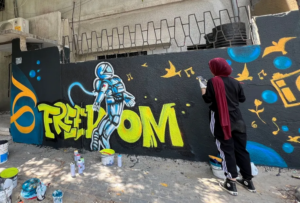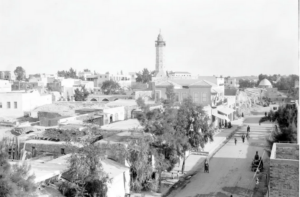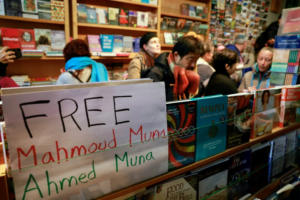‘We had the sea, we had places to go. I miss it’: capturing the spirit of Gaza in a book

Gazan artist Fidaa Al-Hasanat painting a freedom mural at the Shababeek for Contemporary Art gallery in Gaza City, May 2023
Netta Ahituv writes in Haaretz on 13 February 2025:
“I was born in a peculiar year. Before 1982, there was no real border between Gaza and Egypt. But because of the agreements between Egypt and Israel that came into effect forty days after my birth, the international border was driven right through the middle of our house. I was actually born in Rafah, Egypt, but we were forced to choose which side to be on, so we moved to Rafah, Palestine. Some of my uncles stayed, though – I’ve never met them, but I remember as a child we would go to the border fence and shout across to them in Egypt through the barbed wire. We lost the house, of course” Atef Alshaer, from “Daybreak in Gaza”
Atef Alshaer has lived in London for the past 26 years, but the childhood he spent in Gaza remains vivid in his mind. These are not just memories, though, but an intrinsic part of his identity. Married to a Gazan doctor and with one daughter, he carries Gaza wherever he goes – as painful as it may be to do so.
He reminisces fondly about its food and is keen to analyze its sources, as he writes in “Daybreak in Gaza”: “I remember when shawarma first came to Rafah, in the late 1990s: we didn’t have it before. It’s a Levantine thing, so maybe they had it in Gaza City; I don’t know. Fish is not such an important part of culinary culture in the West Bank, but Gaza has fish dishes that are unique, like zibdiyit gambari, spicy prawn tagine. That’s very Gazan. Then there’s feseekh, dried, salted and fermented grey mullet. It’s totally Egyptian, eaten nowhere else – except in Gaza at Eid.”
During a video conversation from his office in London, where he works as an Arabic language and culture teacher at the University of Westminster, Alshaer elaborates: “Because of the isolation that’s been imposed on Gaza, it has a unique culture that is neither Egyptian nor exactly Levantine, though it has elements of both.
“My family came to Gaza in 1948 from Be’er Sheva – what is considered historic Palestine – so their food customs were Levantine. But in Gaza, their palates have been influenced by the local population, who themselves were influenced by Egyptian food. This results in a unique fusion, a mishmash of cultures. Gazan food is very special. I miss it here in London.”

A photograph showing Gaza City in the 1920s
His recollections are part of a new collection of cultural tales from people who either live, lived in or know Gaza very well. “Daybreak in Gaza: Stories of Palestinian Lives and Culture,” was published in English by Saqi Publishing House last October. The anecdotes were edited by Mahmoud Muna and Matthew Teller, with the assistance of Juliette Touma and Jayyab Abusafia.
Muna is a writer and publisher who runs two well-known and celebrated bookshops in Jerusalem that have become centers of its literary scene. He made headlines worldwide this week when he and his nephew Ahmed were arrested “on suspicion of selling books that contain calls for hatred” in their bookstores. After being released on Wednesday, Mahmoud told Haaretz’s Nir Hasson: “All the books in the store are also in the National Library – all were published by reputable publishers. We challenge the Israeli narrative, but also the Palestinian narrative.”
“Daybreak in Gaza” is obviously one of the books on sale in his store. It seeks to preserve, at least in words, the Gazan cultural heritage as it is seen by Gazans through literature, food, music, plays and storytelling. It contains vignettes composed by artists, doctors, students, teachers and more, across the generations.
Although the current war in Gaza is not at the forefront of the texts, it is very much present in every word. Reading the book while knowing how vicious the circumstances of the war are in the region, for both Israelis and Gazans – and how devastating it is for Gaza’s cultural and educational institutions – gives it another layer of meaning.
“I’m thirty-five years old, married and a mother of two children. My daily routine was amazing. I worked as a project officer at one of the local institutions here. I started my day walking beside the sea on the Corniche. After work I would go to the gym, then spend the evening with my children and friends. We had visits, we had outdoor activities – we had too many things to do, in fact. We had the sea, we had a great beach, we had places to go. I miss this life” – Noor Swirki, journalist
Perhaps the book’s most significant achievement is how it humanizes the Gazan people. Here, they are not just numbers quoted in a death toll, or simply victims or aggressors – they are people with a unique culture, vibrant lives, and individual joys and sorrows.The editors’ wish, as written in the book’s preface, is to “stand as a mark of resistance to the destruction, and as a testament to the people of Gaza.” The metaphor of ‘Daybreak’ delivers a hopefulness that just about everyone we spoke to emphasized to us,” says co-editor Teller, a U.K.-based author and broadcaster with a special focus on the Middle East.
Mahmoud Darwish spoke about cultivating hope. Cultivation is a very powerful idea. Hope isn’t something we can pick up ready-made off the shelf – we need to plant it, nurture it, feed it, and then it will grow and transform us. Hope runs through the whole book.
“Even amid the horror, people wanted us to understand that Gaza is not finished and that this book should not be a eulogy,” he adds. Palestinian poet Mahmoud Darwish “spoke about cultivating hope. Cultivation is a very powerful idea. Hope isn’t something we can pick up ready-made off the shelf – we need to plant it, nurture it, feed it, and then it will grow and transform us. Hope runs through the whole book. In [Palestinian academic] Edward Said’s words: ‘Hopelessness is submission,’ which is a privilege the people of Gaza cannot afford.”

A sign displayed in support of Palestinian booksellers Mahmoud and Ahmed Muna, as supporters visit their Educational Bookshop in East Jerusalem on 10 February 2025
Wartime challenges
Receiving the texts from people in Gaza posed a challenge in itself due to unstable communications during the war. The editors used whatever means were at their disposal – phones, emails, text messages, voice messages – to speak with the people and collect their stories.
“Initially, we were not sure how the Gazans would respond to our request to participate in the book, how much they would be willing to share their stories in times of war,” says co-editor Muna, who was interviewed for this article prior to his arrest.
“But we were happily surprised at how much people wanted to be heard in an unfiltered voice and to speak about a range of things that are not necessarily their political analysis of the situation,” he says. “They wanted to speak about their lives before the war, about their dreams for after the war and about what Gaza means for them.
“Their generosity to share touched us,” he adds. “We had a feeling of urgency, because we were not sure about the safety and actual condition of life of those people who we were interviewing: we didn’t know who would still be alive the next day. That was another driving force of the book – to capture as many stories as we could before they might get lost forever.”
“Today, I think I’m in a phase of depression or denial over what’s happening in Gaza. It’s simply too much to process. I’m grieving that the Christian community, which has such a long history in Gaza, is disappearing – not as part of a natural progression, but because of ethno-religious cleansing by the occupiers. We have been misrepresented as bloodthirsty, illiterate terrorists, but we are not. We are a beautiful, life-loving, caring community that will host you, feed you and protect you. The world needs Gazans – people who refuse to give in to despair, who will always find a way to prevail. You cannot erase Gaza.
You can occupy Gaza, you can destroy Gaza, but you will never take it away from us. We will always rebuild Gaza – in our memories, in our imaginations and in our hearts, until one day we will rebuild Gaza for real” – Yousef AlKhouri, theologian and interfaith activist
Touma, the director of communications for the UNRWA refugee agency covering the Palestinian territories, Syria, Lebanon and Jordan, had visited Gaza several times both before and during the war. (She stresses that the book and her part in it are independent of her work at UNRWA.)
“The connection that I developed with the place and its people is my drive for this book and for my work,” she says. “One year before the war started, I happened upon Darwish’s poem ‘Under Siege’ – ‘Here on the slopes of hills / facing the dusk and the cannon of time / Close to the gardens of broken shadows/ We do what prisoners do/ And what the jobless do / We cultivate hope’ – written on a wall of the dining room of the hotel I stayed at in Gaza.
“And when I heard Matthew and Mahmoud’s idea for the book, I immediately knew that this poem’s message should be part of it. Moreover, that we should do whatever is in our means to remind the world of what Gaza was – not only before the war, but also before the blockade, before the second intifada, back in the 1960s and ’70s, and even thousands of years ago. It was a diverse and cultural place, and I think the world needs to know about it.
She notes that “even when people are living in abject poverty, in the most horrendous degradation, they don’t lose their culture. Gazans are no exception – they haven’t become a culture-less people of survival alone. They have culture. They have literature, art, music and, when possible, also culinary culture. The book shows how, against very challenging living conditions, against poverty, unemployment and blockade, the people of Gaza were finding creative ways not only to survive but to live.”
Touma adds that she believes the Gazans have a real sense of joie de vivre, which helps inspire their creativity. “Thanks to that, you can now see people dressed as clowns in the refugee camps trying to cheer up children, or a woman with a briefcase trying to set up a mobile school and teach kids,” she says.
‘Message of hope’
“Returning through the outskirts of Gaza City, and just around the corner from al-Shifa Hospital, you drop into Shababeek, Gaza’s first contemporary art gallery, established in 2009 by artists Majed Shala, Basel El Maqusi and Sherif Serhan. One floor is given over to painters’ studios, and a loft has been converted into a sculpture workshop. Shababeek has come to be one of the most important art spaces in all of Palestine. Moving towards the oldest part of Gaza City, you pass through packed streets and busy markets. Many of the buildings here are painted; there are murals and street art wherever you look. In the heart of the old town, in the Daraj neighbourhood, you reach the Great Omari Mosque. This mighty building with its basilica-style architecture stands over what remained of the Cathedral of St John the Baptist, built on the same site by the Crusaders in 1149 and mostly destroyed by the Muslim leader Salah al-Din in 1187. It is famous for its spectacular columns and inscriptions, and is impressive in size” – Caitlin Procter, political anthropologist
The editors are currently promoting their book internationally and are speaking about Gazan culture. Teller says the events are proving emotional but also optimistic, because this is what the contributors want. “There are some key messages that the participants of the book were transmitting to us and we are in turn transmitting to audiences. One is the clear message of hope,” he says.
Muna adds: “Another message we were asked to convey through the book is that the people in Gaza are not villains and they’re not superheroes. They are humans who found themselves in a terrible situation.”
For Touma, the book’s raison d’être is to make people think of Gaza beyond the headlines. “Gaza has been dominated by the demands of the news cycles – and that’s the case whether you look at it today or whether you looked at it in 2014 or 2008,” she says, referring to previous wars there.
“Gaza is always seen only through the context of what’s happening exactly now and how terrible it is. One of the motivations for the book is to lift Gaza out of the present moment and present it to the world in a broader light.”
“Daybreak in Gaza: Stories of Palestinian Lives and Culture” is out in paperback, published by Saqi Books.
This article is reproduced in its entirety
